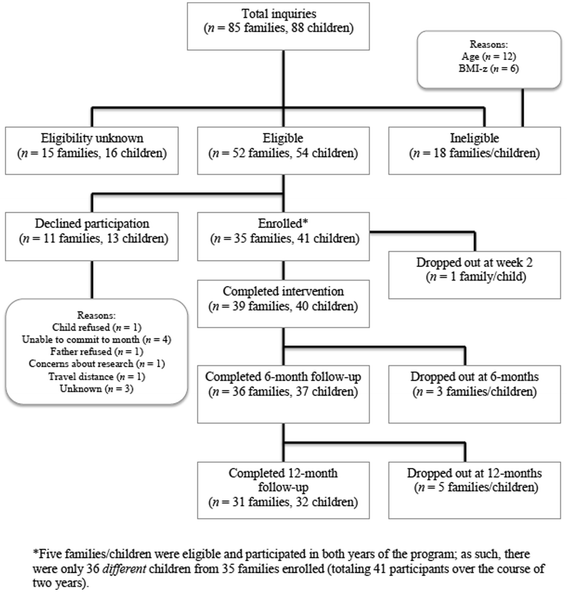Using the RE-AIM framework to evaluate a community-based summer camp for children with obesity: a prospective feasibility study
- PMID: 26217536
- PMCID: PMC4511021
- DOI: 10.1186/s40608-015-0050-8
Using the RE-AIM framework to evaluate a community-based summer camp for children with obesity: a prospective feasibility study
Abstract
Background: Increasing rates of childhood overweight and obesity highlight a need for the evaluation of lifestyle interventions. The purpose of the study was to determine the Reach, Effectiveness, Adoption, Implementation and Maintenance of a novel family-focused program targeting children with obesity (i.e., the Children's Health and Activity Modification Program [C.H.A.M.P.]) using the RE-AIM framework, an evaluation tool for community-based health interventions.
Methods: A single-centre, single cohort interventional feasibility study was conducted over the course of two years. Children with obesity and their families completed a 4-week group-based lifestyle intervention in Year 1 (n = 15; M age = 10.6; 53% female) and/or Year 2 (n = 25; M age = 10.6; 56% female). Outcome variables were measured pre- and post-intervention, as well as 6- and 12-months following completion of the formal program.
Results: Overall, C.H.A.M.P. had high reach in terms of participant representativeness. In addition, participation in the program was associated with significantly improved standardized body mass index (BMI-z), body fat percentage, lean mass percentage, and child- and parent-proxy reported quality of life (QOL; effectiveness/individual maintenance). Furthermore, a number of community partnerships were built, strengthened, and maintained prior to, during, and following implementation of the two-year program (adoption/setting maintenance, respectively). Finally, the intervention was delivered as intended as evidenced by high adherence to the schedule, attendance rates, and cost effectiveness (implementation).
Conclusions: Based on RE-AIM metrics, C.H.A.M.P. appears to be a promising childhood obesity program. The findings reported will inform researchers and practitioners on how to design and implement future community-based programs addressing pediatric obesity.
Trial registration: ISRCTN Registry, Study ID ISRCTN13143236. Registered 27 March 2015.
Keywords: Childhood obesity; Community intervention; Family health; Feasibility; Group dynamics; Program evaluation; Quality of life; RE-AIM.
Figures
References
-
- World Health Organization: Global strategy on diet, physical activity, and health: childhood overweight and obesity. http://www.who.int/dietphysicalactivity/strategy/eb11344/strategy_englis... (2014). Accessed 4 Jan 2015.
-
- Roberts KC, Shields M, de Groh M, Aziz A, Gilbert J. Overweight and obesity in children and adolescents: results from the 2009-2011 Canadian health measures survey. Statistics Canada, Catalogue no. 82-003-XPE, Health Reports. 2012;23(3):37–41. - PubMed
LinkOut - more resources
Full Text Sources
Other Literature Sources


